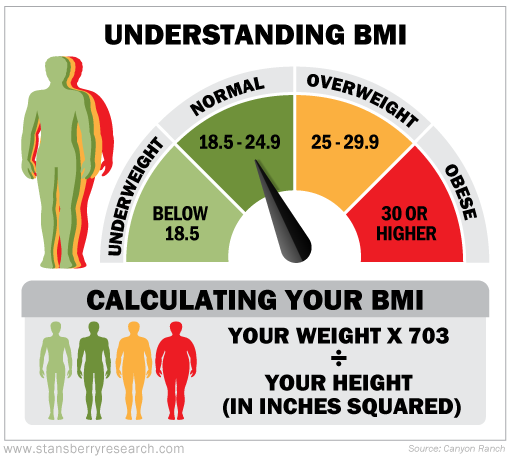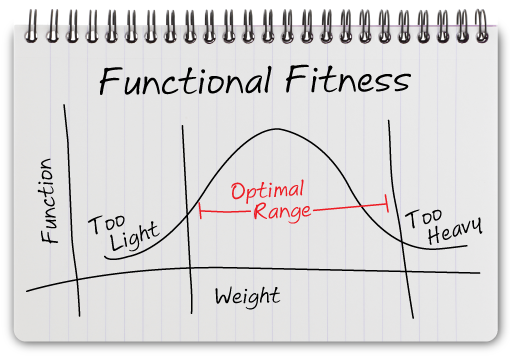Doc's note: Yesterday, we told you about the myth that dietary fat is bad for you. Today, we're covering another fat myth... That you need to be skinny to be fit.
***
The great weight debate...
For decades, people have believed that "thin" equals fit and healthy. According to this belief, folks who are "overweight" can't be in good shape or healthy.
Even doctors are biased against overweight folks...
A 2019 study found that out of 400 practicing family physicians, 24% indicated a dislike of having friendships with those who are obese, 33.3% indicated frustration with obese patients, 27.8% believed obese patients are noncompliant with treatment recommendations, and 18.5% indicated feelings of disgust when treating an obese patient.
The standard for labeling a person's weight status is the body mass index ("BMI") measurement. The BMI calculation is a simple formula...

However, this measurement is a poor representation of a person's health. It was developed by a mathematician – not a physician – and it ignores many important factors to a person's size... like weight proportion. There is no consideration for a person's bone, muscle, and fat ratios – so physically fit people can still fall into the category of being obese by this ridiculous measurement. And, of course, if the system can label you as something "bad," then there's potential for a drug to be sold to you to make you better.
Strangely, (I'm a normal distribution guy) just 1.5% of adults in the U.S. are considered underweight, 32.5% are overweight, and 36.5% are obese.
Of course, if you're carrying too much weight, it can put undue strain on your heart, joints, and bones. However, if you're too thin, you may not have enough strength to carry out day-to-day tasks, so you're more prone to serious injury if you fall because your bones are weaker. On top of that, underweight folks typically have weaker immune systems.
Here at the Health & Wealth Bulletin, we like to say that a person's ideal weight is tied to their ability to physically function, and it follows our favorite U-shaped curve... Now, what do we mean by functional fitness? It's simple...

We're talking about a person's ability to physically perform activities necessary for everyday living – like getting dressed in the morning, getting from point A to point B, and preparing meals.
Functional fitness exists on a continuum in that almost all exercise can be functional, depending on the context of the activity. And if you're so light that you can't lift your coffee or too heavy to walk to the mailbox... you're clearly not functionally fit.
This changes your focus from the bathroom scale to your actions... Are you moving for 10, 30, or 60 minutes a day? Does your diet normally consist of whole foods or junk? Do you find yourself saying no to activities you'd like to be able to do but think you're not in the right shape for?
You can test yourself by taking a standard functional fitness assessment. Your scores can be a great indicator of where you currently stand and what areas may need some improvement.
The Functional Fitness Test
The functional fitness test consists of seven steps that must all be completed in succession:
- Aerobic fitness test
- Five minutes of rest
- Upper body strength and endurance
- Three minutes of rest
- Lower body strength and endurance
- Three minutes of rest
- Core strength and endurance
You will need a timer to complete this assessment, as well as a pen and paper to keep track of your scores. If you are unable to do a portion of this test (due to injury, for example), you are to score yourself with a zero for that section.
It will also help keep you honest by doing this assessment with a partner (no cheating!). This way, if your form is off or the motions are no longer continuous, you know it's time to stop and record your score.
Step 1: Aerobic Fitness Test
For the aerobic portion of the test, you must either run one mile, walk one mile, or row on a machine for four minutes.
If running, you may run, jog, or walk any part of that mile. If you're walking, you can only walk for the duration of the mile.
Record your time at the end of the mile. If rowing for four minutes, record your distance (in meters) at the end of the time.
Step 3: Upper Body Test
The upper body test consists of full pushups (from your toes with your hands approximately eight inches apart). In the "up" position, your back must be straight, and your elbows must be fully extended.
Do as many pushups as you can without resting. If you have a partner, they can remind you three times to move continuously, but the test ends on the fourth reminder.
It's important to breathe throughout this motion (inhale going down and exhale going up) because you can really injure yourself if you start holding your breath.
Record the number of pushups you do.
Step 5: Lower Body Test
The lower body test is measured with squats. Begin by standing with your feet slightly wider than shoulder width apart and your toes pointing slightly outward.
Bend your knees so that your legs form a 90-degree angle and then come back to a standing position. That counts as one squat. Do as many squats as you can do continuously, making sure that your knees do not extend beyond your toes when squatting.
If you delay longer than one second in between squats, you get a warning to keep going. You have a maximum allowance of three warnings, and the fourth one ends the test.
Inhale as you squat down and exhale as you stand up. Do not hold your breath. When you have done all that you can do, record your number on your sheet of paper.
Step 7: Core Test
The core test score is determined by how long you can hold a plank (in seconds). The plank position requires you to be on your toes with your forearms flat on the ground. Your back and rear end must be lined up flat, with your head in neutral position and your legs straight.
If your back dips or arches, you get one warning to return to the proper position. If this does not happen immediately, the test ends. You get a maximum of three positioning reminders, and the fourth ends the test. If your knees or stomach touch the ground, the test is over.
Again, do not hold your breath during this test. Record your time in seconds once the assessment has been completed.
If you find that you don't do so well the first time around taking the functional fitness test, that's fine. The first step in change is always awareness... You now have a goal to work on.
And let's talk about food for a minute...
Are you someone who eats for convenience, or are you the type of person who puts a lot of thought behind your meals?
Eating mindfully – by staying aware of what foods and drinks you put into your body and why you are choosing to eat in a given moment – promotes better digestion, keeps you feeling satisfied for longer, and helps you make better decisions about what to eat.
So, ditch your preoccupation with the numbers on your bathroom scale and give the functional fitness test a try...
Go do the test now... get your data... and see how you stack up against others in your age group here: Functional Fitness Assessment Protocol and Testing Standards.
Be aware that some of the results differ based on gender... The female charts are not well labeled, but you can tell because they have lower numbers for repetitions and distance and higher values for time.
Also, hang on to your scores so that the next time you take the functional fitness test, you can see how much progress you've made. Let us know how you did by sending us an e-mail to [email protected].
Here's to our health, wealth, and a great retirement,
Dr. David Eifrig and the Health & Wealth Bulletin Research Team
December 28, 2022
